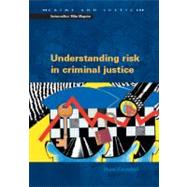
| Series editor's foreword | p. xiii |
| Acknowledgements | p. xv |
| List of acronyms | p. xvi |
| Introduction | p. 1 |
| Framing the problem: contemporary responses to high risk offenders | p. 3 |
| Introduction | p. 3 |
| Who are high risk offenders? | p. 5 |
| Can we know them? | p. 7 |
| Risk assessment tools | p. 8 |
| The problem of risk prediction | p. 9 |
| Differing interpretations of risk | p. 11 |
| Criteria and evidence | p. 12 |
| The rise of community protection | p. 13 |
| Limits to the community protection model | p. 18 |
| Protection or punishment? | p. 21 |
| Exclusionary or integrative? Alternative approaches to risky offenders | p. 21 |
| Notes | p. 23 |
| Further reading | p. 23 |
| Useful websites and key sources | p. 24 |
| Differing perspectives on an old problem: how do we know the dangerous? | p. 25 |
| Introduction | p. 25 |
| The long view | p. 26 |
| Framing risk and dangerousness | p. 30 |
| Criminological and legal approaches to risk and dangerousness | p. 30 |
| Psychological framing of high risk offenders and dangerousness | p. 34 |
| Sociological understandings of risk and dangerousness | p. 37 |
| Governance: surveillance, social sorting and social regulation | p. 40 |
| The limits of governmentality, surveillance and social sorting | p. 42 |
| The social construction of risk and the role of the media | p. 43 |
| Conclusion | p. 46 |
| Notes | p. 46 |
| Further reading | p. 47 |
| Risk assessment: difficulties and dilemmas | p. 48 |
| Decision making on risk: the key issues | p. 48 |
| Categories and thresholds of risk | p. 49 |
| Systemic faults in risk assessment | p. 53 |
| Individual sources of error | p. 55 |
| Solutions for reducing error | p. 59 |
| What do offenders think about risk assessment? | p. 62 |
| Summary | p. 64 |
| Notes | p. 64 |
| Further reading | p. 65 |
| Protection through partnership | p. 66 |
| MAPPA: the statutory approach to public protection | p. 67 |
| Key issues in statutory partnerships | p. 71 |
| Public health and community approaches to protection | p. 73 |
| Partnerships with local communities: Circles of Support and Accountability (COSA) | p. 74 |
| Partnership with communities and public: building awareness and responsibility | p. 78 |
| Building awareness and responsibility | p. 79 |
| Protection through partnership: a summary | p. 83 |
| Further reading | p. 84 |
| Risk management | p. 85 |
| Introduction | p. 85 |
| Community protection risk management strategies | p. 86 |
| Supervision and monitoring | p. 88 |
| Cognitive behavioural treatment and intervention programmes | p. 89 |
| Evaluations of CBT | p. 92 |
| Beyond the punishment paradigm - PHA, 'good lives' and risk management | p. 94 |
| Prevention strategies and environmental/opportunity management strategies | p. 97 |
| Social inclusion and integration techniques, including prosocial statutory supervision | p. 102 |
| Relapse prevention | p. 105 |
| What is the potential for restorative approaches? | p. 106 |
| Summary | p. 107 |
| Notes | p. 108 |
| Further reading | p. 108 |
| Key issues in managing high risk offenders | p. 109 |
| Introduction | p. 109 |
| Risks versus rights | p. 110 |
| Ethical issues | p. 113 |
| Community notification | p. 115 |
| The situation in the UK | p. 118 |
| Supervision and monitoring | p. 123 |
| Evidence of effectiveness | p. 124 |
| Community protection or reintegration: competing or complementary approaches to the community management of high risk offenders? | p. 126 |
| Summary | p. 128 |
| Notes | p. 128 |
| Further reading | p. 128 |
| Concluding comments | p. 130 |
| Pulling the threads together | p. 130 |
| Blending protection | p. 132 |
| Glossary | p. 134 |
| References | p. 136 |
| Index | p. 165 |
| Table of Contents provided by Ingram. All Rights Reserved. |
The New copy of this book will include any supplemental materials advertised. Please check the title of the book to determine if it should include any access cards, study guides, lab manuals, CDs, etc.
The Used, Rental and eBook copies of this book are not guaranteed to include any supplemental materials. Typically, only the book itself is included. This is true even if the title states it includes any access cards, study guides, lab manuals, CDs, etc.